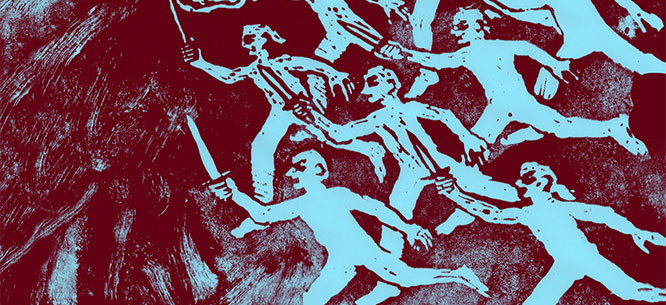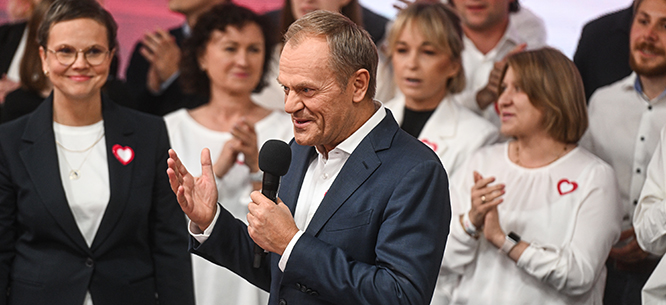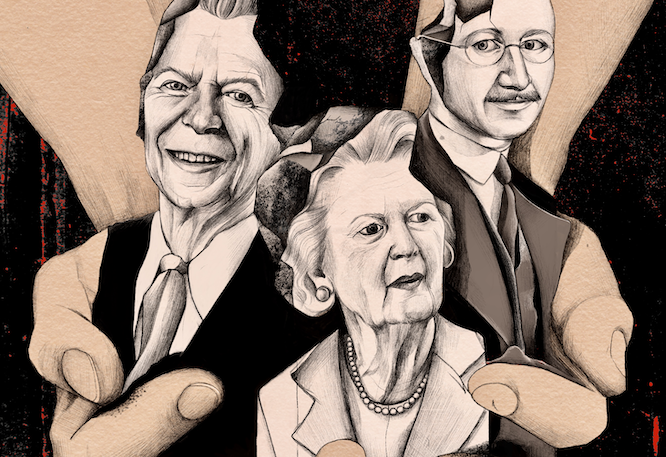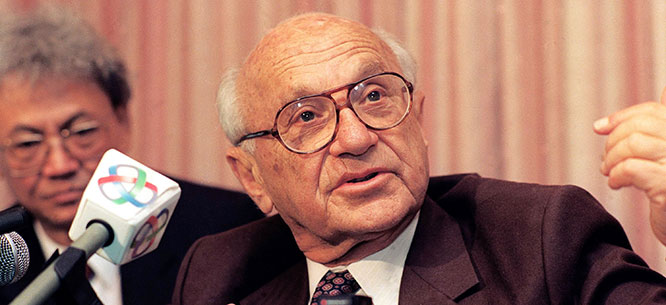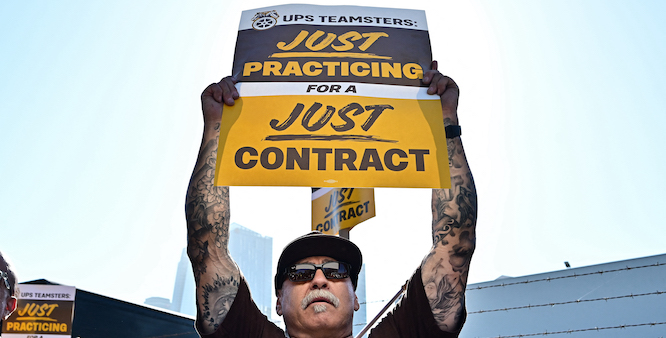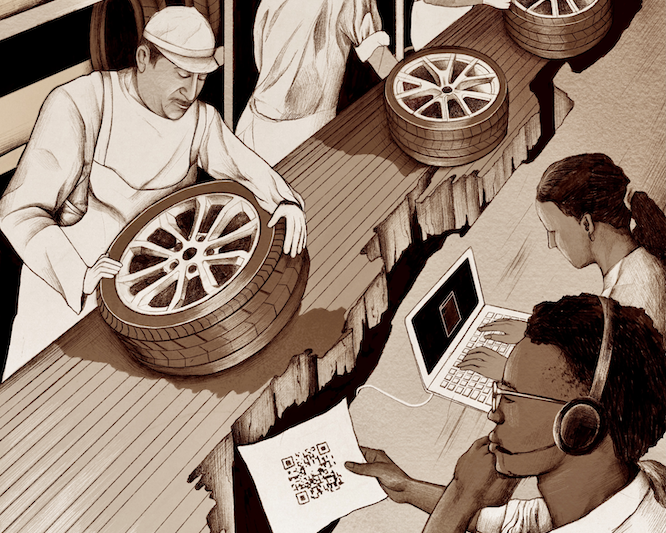The rain has been almost constant these early months of 1996. Great storms from the US have arrived even to here, the Caribbean coast of Honduras, thousands of kilometers to the south. At times in Tela, the run-off courses thigh-deep.
And every day, it seems, some piece of news about those Northern-owned Fruit Companies has flooded the papers. A banana war has begun between them and the European Community. Accusations and denials gust through the pages of El Tiempo and La Prensa.
In February, I read in La Prensa of some campesinos who have taken over lands of the Tela RR Co. The Company official’s words echo through my mind: “I’m glad the military used no force. I’m glad the government respects private property rights.” I’d like to hear those campesinos’ stories. Tacamiche. I can’t find this village on any maps.
Another gust flutters the pages of the dailies in my hands. The Honduran government has said no to any attempt by the Tela RR Co. to decrease train service. The poor need an inexpensive means to travel, argue the politicians. I pull out the maps again.
The Ferrocarril Nacional owns the lines from Puerto Cortés to Baracoa, and beyond to San Pedro Sula. The Company, the one from Baracoa to Tela—as well as others running deep into the fincas. There are really three Chiquita trains: one that makes a trip through those plantations between El Progreso and La Lima; The Machangay, a weekly service from that Port to the emerald hearts of their lands, carrying merchandise to the Company stores; and, in part, from Puerto Cortés to Tela.
If I can’t find Tacamiche, I can surely find a railroad.
The weather, for the first time in weeks, is sunny—and muggy. But I won’t be prepared for the storm that will cast me in a whirlwind for the next thirty-six hours.
*****
In the cracking dawn, I gather with many others for a train to Baracoa, then on to Tela. Opposite this Portón Nº 7, is the shell of a building. Its brick and concrete crumble under today’s dry sky. The metal date is still intact: 1922. Its former name is a faint shadow: Hyller Ralston and Son.
A thin-limbed ladino wobbles from one person to another, showing off his pride. From his front pocket, he pulls out an ancient, long-barreled revolver.
The train arrives. The rush is on. Quickly the cushioned seats in the lone first-class car are taken. I opt for a wooden one in second. There are three of these wagons, as well as four fruteros converted to passenger use, two baggage cars, and the locomotive.
Our journey begins, clattering through the awakening city, over a bridge spanning a laguna. Shanties built upon stilts above the marshy ground. In the window of one, a woman washes dishes. The sink hangs off the sill. Soiled water drains to the swamp below.
Though it is still early, the swelter grows. I tuck my journal into my back pocket, leaving the scenes of small rustic settlements and molded Company towns that slip by my window.
Through the fruteros, stepping over people’s legs stretched out to the center bench. Perdone … con permiso … To the first baggage car to buy a soda. But the entrance is jammed with passengers and bundles of firewood. I return to my seat, stepping over legs, defeated.
“What’s the matter?” The words cut through my self-pity. I hadn’t noticed someone’s eyes were watching me on my unsuccessful quest. An Afro-Honduran man studies me with deep brown eyes.
“Oh, I thought of getting a gaseosa. But the way is blocked.” I shrug and begin turning towards my car.
“What flavor would you like?” He gets up from his place.
“Oh, no,” I shake my head, single braid wagging. “It’s all right, señor.”
“No, I insist. Sit down, please.” He offers the bench with an open hand. “What kind would you like?”
“Grape would be fine, please.”
Within minutes, he returns. One chocolate-colored hand embraces the bottle.
“How much do I owe you?” I reach into my pocket after taking the lukewarm soda.
He smiles. “Nothing. It’s my treat.” He sits next to me.
This is Eduardo, going home to San Juan, a Garífuna village near Tela. He farms some land there, in the mountains. For more money, he fishes a few months at a time, out of Puerto Cortés.
Flashes of sunlight through the slats of this frutero dance within the car. We talk about the railroads here, and their owners. Our conversation flows to the banana companies: who they are and where they rule.
West of Tela is Chiquita-land with bananas and citrus. It used to be United Fruit. East of Tela—La Ceiba, Trujillo—belongs to Standard Fruit, or Dole. It mainly grows bananas and pineapples. Nueva Tela and Lancetilla were United’s territory.
“And there are others, too. A new one, also from the United States. … No, it’s independent from the other two.” Eduardo blows the smoke of his cigarette. It swirls in the sunlight slipping in. “There was some old company, Italian.” He shakes his just-beginning-to-grey head. “I don’t remember the name any more. It, too, used to be on the coats. But it got bought up years ago.”
I take a swig of my grape gaseosa, listening to his melodic voice.
He wrinkles his brow, eyes squinted in thought. “And there was another—Cuyamel. It worked west of Puerto Cortés. It got bought up, too. There aren’t any fincas that way any longer.”
I wipe my mouth. “Why’s that, don Eduardo?”
He shrugs. “I suppose because the soil’s not as good. Lots of small plantations there, though. Some are collectives, others private. They grow bananas, sugar cane, yucca and the like.” His flicked ash falls through a hole rotted in the wooden floor.
I place the bottle between my feet. “Just on the other side of the river there, in Guatemala, the Company has many large fincas.”
“Oh, yeh.” His smile is bright. “They’ve got some very good land there.”
“You know, don Eduardo,” I look him in the eyes, “it’s good to meet someone who knows so much about the bananeras. So many Hondurans have told me differing things. Like Tela had belonged to Estandard Fruit.”
He laughs quietly. “Well, I know some, because I’ve travelled so much around the country.” He falls serious. “Plus, if I don’t know something, I say I don’t know, instead of pretending I do and misinforming.”
I nod, picking up my soda. I sip the last of it.
“And I used to work for the Company many years ago.”
I glance at him. His eyes are gazing at something in that past. “When was that?”
“Oh, ’51 to ’66.” He drags his cigarette.
“Wasn’t there some sort of big strike back then? In ’53 or ’54?”
“Fifty-four.” His head moves plaintively up and down. “You had to conform.”
“And how was it?”
Eduardo turns to me. “Low pay. Had to conform. Step out of line, and you were out.” He tromps his bud. “I decided to get out of that. Went to work in other agriculture and fishing. I devote myself to that now.”
I hold the empty bottle up. “Well, I guess I should go return this.”
On my pass back through, Eduardo nods towards the landscape. “We’re already coming into Tela.”
I peer out between the slats. We’re entering the railyard. This train clatters by the old Tela RR Co. building and decaying frutero cars.
“Don Eduardo, thanks for the soda—and the lessons.”
He nods de nada with a smile.
I go to my second-class seat to retrieve my knapsack. I watch our approach through the open window. We have pulled onto the fractured pier, and now backing along a spur line. Beneath a bridge, the river swirls black-green and tan-grey. We arrive at the Old Tela station.
I lose sight of Eduardo in the crowd on the road leading past the cheap-dive hotels and market. The mud is crusting into ruts. The late-morning sun is strong.
I have no interest in spending even a night here. The five weeks I’d spent in February, going into March, was enough. I head straight for the bus terminal. I’ll go to La Ceiba, the cradle of Standard Fruit. Then on to Trujillo.
*****
A thin wind whirls dust and litter around my feet. I step through the rear door of this school bus. It is dim inside. Most seats are already taken.
A young ladino, perhaps mid-20s, offers the one next to him, in the back here. As soon as I sit down, he says with a big smile, “So, are you from the United States?”
Oh, boy, this is going to be a long ride. “I’m from Alaska,” I respond flatly.
“Oh.” Disappointment washes over his bony face. “I thought …”
A heavy silence drifts between us.
I look away. I feel a hollowness in the pit of my stomach.
“Well, I work at Estandard Fruit.” He pulls out his worn leather wallet and hands me his identification card. “In a packing plant. Four years now.”
Bewilderment washes over my face. “That’s strange. On the train from Puerto Cortés just now, I met a man who used to work for the Company. He said wages were low and one had to conform.”
This young man nods enthusiastically. “Oh, yeh.”
He leans over the back of the seat, pulling off his ball cap. He fans a banana box in the cargo hold behind us.
“What you got there?”
“Oh,” he sits back down with a clunk. “A hen, a rooster—and five chicks. I have my own piece of land now and setting up livestock on it.”
“Once you get it established, are you going to leave the Company?”
The cock crows.
The man’s head bobs with a slight grin. His eyes twinkle.
“So, how much do you earn?”
“Oh, 25 lempiras a day. Per month, 750.”
About minimum wage here. At the present exchange rate, that would be about $70US per month.
“I saw in the newspapers that the minimum wage will be increasing soon.”
He shakes his head. The sunlight shimmers on his black hair. “I’m not so certain.”
“Why’s that?”
“Lawyers of the big companies are fighting it.”
I’d read that, too.
He reaches back to fan his chickens again. “I have to keep my investment cool,” he says with a laugh.
I smile at him.
That sunbeam is so warm. This has already been a long day. I begin nodding off….
I awaken, my shirt damp with sweat. It’s hellaciously hot. I reach for my water bottle.
My seatmate is cooling his chickens once more. He grins fincas are fading into miles of pineapple groves along either side of the highway. We are nearing La Ceiba.
*****
Once settled into this city, I wander through the central park. Caimans and turtles are keeping cool in their tank beneath the massive rubber tree. And I wander across the Avenue to the railroad park in the Company town. Under an ancient mango tree, a couple trysts. A slight breeze rustles its lance-shaped leaves. A mosaic of leaf-shadow and sunlight dances on the brick path.
I’m reading the sign by the old San José locomotive. A man walks up behind me. He watches me write, I see from out of the corner of my eye, and the holstered pistol he wears.
Many times during my journeys, I have found my fascination for trains intermeshing with the history of the banananeras.
I turn around to face him. “Excuse me, sir. Do you work here?”
“Sí, senora.” This ladino studies me: long hair in a single braid, blue jeans, tennis shoes. His face is official. “I work vigilance in this park.”
“Pues, perhaps you can help me. I am writing a book on train journeys. I understand there might be cargo service to La Ceiba. Is that true?” I’ve long wanted to travel these lines around here. But a previous visit to Sambo Creek proved it couldn’t run very far east.
“No, Estandard Fruit doesn’t ship by train any longer. It uses trucks. All the lines now belong to the government. There is, however, a special tourist train every day.”
“What hours does it run, señor?”
“From seven in the morning until about six in the evening. Every hour and a half or so.” His arms are crossed. He watches me jot this down.
“And where does it go to?”
“To a pineapple plantation about a kilometer from here.”
Hmmm, this could be a fun ride. “How much does it cost, sir?”
“Seventy centavos each way.” He turns to a taller, stockier man who just walked up to us. He also wears a pistol.
“The railroad station here in the park. Is it the original passenger station?”
The first man shakes his head. “No, it’s out in a neighborhood …”
“Quite a distance from town,” his co-worker interjects.
“It’s now in bad disrepair,” the skinnier one finishes.
“Was this, then, the station for the Company town and headquarters?”
They shrug.
The brusquer one responds, “The main Company headquarters has always been elsewhere.”
I raise an eyebrow. That’s different. “Where is that, señor?”
“I don’t remember the name of the place. But this,” he nods his head towards the white cookie-cutter buildings, “was a local branch, until two years ago. These offices now handle tourism for this park, and for Cuero y Salado.” Cuero y Salado is a natural reserve about 30 kilometers west of La Ceiba—as the vulture flies.
I look at him questioningly, “Why did it move?”
“Well, with the change of president two years ago, the Company pulled out majorly from the area. The previous administration had been funding a new port for Estandard Fruit east of here. But with the change, Estandard said no. So, now the new government has had to abandon the port. It’s not completely built.”
“Pues, why did the Company decide to pull out of the project?”
“Oh, the new government only cares about,” his broad face scrunches, “its ‘moral revolution.’” His stubby fingers quote those last two words. “It doesn’t care about the country itself. Just look at the condition of the roads along this coast.” He spits on the ground.
“When did Standard stop using La Ceiba as a port?”
The first man looks at his partner before responding, “1986.”
“You’d said Estandard had majorly pulled out. In what ways?”
The second ladino wipes his mouth. “Sí, it’s dropped more and more operations. This port …”
“… the railroad,” adds the other.
“The port project.”
“Oh, and it closed down big pineapple fincas to the west.”
“And those African palm plantations outside of town. To whom do they belong?”
The two men look at each other. The larger one answers, “They’re mostly Honduran companies.”
“Well, we should be getting back to work.” The thin man elbows his co-worker.
“Sí, we have to make sure no-one steps on the grass or anything. Adiós, señora.”
I stroll across the park, to the Avenida, down to the old pier. This is a quieter Sunday than two years ago. No boats await to go to the Bay Islands. A few families sit on the edge, dangling and swinging their legs. A man pulls up his hand-held line. A silver fish flips on the hook. Until dusk, I lean against a mooring, listening to the music of languages around me—Spanish, English, Garífuna. The sunset colors sparkle the blue-green water.
A few clouds speckle this new morning. The sun is already an hour or so old. It plays through the leaves, swaying in a now-and-again breeze.
I sit under the arbor. That finca train should come some time. I must have missed the first one. The time passes. I write. Three women catch their ride to work. I light a cigarette.
A man comes up to me. His Quimipro ball cap casts his serious eyes in shadow. “Excuse me. May I have a cigarette, please?” He sits next to me, blowing the smoke slowly. “Are you waiting for someone?”
“The tourist train. And you?”
“Oh, a lift to Estandard Fruit.”
“Do you work for it?” My flicked ash scurries across the path.
He shakes his head. The scattered sunlight catches on his high cheekbones. His skin is pale. “No, for Blanquita. I used to work for it, though.”
I put my journal under my thigh. “Really?”
“Sí.” He drags his cigarette. “I began there when I was 8. I trained as a locomotive mechanic. I worked ten years for the railroad—two under Estandard, the rest with the government, until it closed down operation of the lines. From there, I went to work for Blanquita, as a processing assessor.”
“And Blanquita. Who does own it?”
“Pues, it’s Honduran-owned and independent. But the real owner is Estandard Fruit. It’s just another arm of it.” He gazes at his hands, then takes another puff. ·The African palm plantations mostly belong to Blanquita. Some, though, are independent farmers who sell the fruits to it.”
“Are the Standard offices here in La Ceiba?” I step on my butt.
“Sí. Those buildings over there.” He points to the large white ones across from the railroad park. “It also has other offices. Out on the fincas, in Puerto Cortés, and Puerto Castilla.”
“Why doesn’t it use the port here anymore?”
With his long, bony fingers, he flicks his remnant into the grass. “It’s obsolete. Can’t handle the big cargo container ships. Now it’s only used to send produce out to the Islands.”
“I heard the government had been building a new port for Estandard. But the project had to be abandoned because the Company pulled out.”
His features become sharper. “It’s a lie.” He glances out to the parking lot. Nothing yet.
And I watch the railroad shed on that other side. Nothing yet, either.
I lean forward, arms on thighs. “Why doesn’t Standard use the railroad any longer?”
One hand rubs a knee of his black pants. “Because of the irresponsibility of the workers.” He looks up. “The Company would hire people to unload boxes from the train when it arrived at the pier.” He nods down towards the seafront. “The workers would stack the boxes four or five high. Many bananas got damaged—more easily done the riper they get. Pues, there were many complaints from the US and Europe. The Company was losing lots of money. So it had to end.”
A silence blows between us. We both study that lot.
His eyes fall to his work-worn hands. “Plus, the workers were mañoso.”
I wrinkle my brow. “Mañoso? What does that mean?”
“Pues, for example. There’s a pineapple finca to the west of here,” he turns and points that way. “Montecristo Piñales. It’s very large. Has permanent employees. Well, they’d report in in the morning, then request to see a doctor. They had a pain here,” he points to his side, “a pain there,” to the head, “everywhere. The doctor would write up a one-week excuse, and Estandard would pay wages for that week.” He looks at me. “It wasn’t just one worker who did that, but many. It cost the Company a lot of money.” He straightens up, his gaze fixed out there. “The plantation is still operating, but with different workers. All of them were replaced. Con permiso.”
He walks off to the parking lot, to a pick-up truck pulled in. I watch him greet a man. They drive away.
I wait for my train a while longer, passing the time scribbling notes in a small red notebook. The leaf-mosaic waltzes over the page, over my hand.
It is now almost 10 a.m. Still no train. I decide to pack it in and go to Trujillo.
*****
During this bus trip, no conversation interrupts my contemplation of the countryside. West of Savá is a kilometers-long banana plantation. White plastic wraps the racimos. Arrow-straight dirt roads lead into its depths. Workers bow under the already-heavy heat of this day. A yellow-red sun warns not to collect fruit.
I pick up today’s La Prensa from my lap. An article catches my eye, about the Port of Cabotaje. This is the one we’d talked about in La Ceiba. Yes, it was built by the previous government. There’s a lack of funding from this new administration to do the necessary dredging of channels to keep it clear.
My pen jolts with the rhythm of the bus. My usual chicken scratch is now almost indecipherable. I glance out. We have now left Savá. Fincas of African palm patch the roadside. I turn my attention back to the story: “… and with the pull-out of Standard Fruit Company, this port lost its importance in the country.”
But there is no mention of why the Company pulled out.
I fold the paper, giving it back to its owner, and stuff the little notebook in my pocket. We are now near Tocoa. “The Cradle of Agrarian Reform,” proclaims a faded sign. Citrus groves blanket the countryside.
*****
Over the next few weeks, those northern storms once more arrive to this coast. The rains muddy the streets of Trujillo. Many days, gusts of wind flutter the pages of the newspapers.
Tela RR Co. executive Fernando Sánchez (formerly the US consul to this country) makes an offer to the government. The Company will invest $100 million US in finca infrastructure and increase previously fallen banana production by 40%. However … Honduras must decrease taxes by 50 US cents per exported box.
More accusations in the Banana War. This in relation to the Stalinsky case. A two-page letter-ad runs, written by a former Chiquita employee. It details the dirty work he claims the Company asked him to do.
And Standard Fruit will be returning to Nicaragua, after having left in 1982 (… during the Sandinista Revolution, which instituted an agrarian reform and new labor laws …).
The drizzle of conversations, too, continues. From public library to the clutter of a museum. From dim market to café. On street corners …
My little book becomes drenched with the rains….
ENDNOTES














